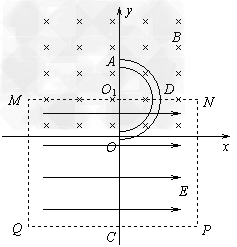问题
计算题
如图所示,在直角坐标系xOy平面内有一矩形区域MNPQ,矩形区域内有水平向右的匀强电场,场强为E;在y 0的区域内有垂直于坐标平面向里的匀强磁场,半径为R的光滑绝缘空心半圆管ADO固定在坐标平面内,半圆管的一半处于电场中,圆心O1为MN的中点,直径AO垂直于水平虚线MN,一质量为m、电荷量为q的带电粒子(重力不计)从半圆管的O点由静止释放,进入管内后从A点穿出恰能在磁场中做半径为R的匀速圆周运动,当粒子再次进入矩形区域MNPQ时立即撤去磁场,此后粒子恰好从QP的中点C离开电场。求
0的区域内有垂直于坐标平面向里的匀强磁场,半径为R的光滑绝缘空心半圆管ADO固定在坐标平面内,半圆管的一半处于电场中,圆心O1为MN的中点,直径AO垂直于水平虚线MN,一质量为m、电荷量为q的带电粒子(重力不计)从半圆管的O点由静止释放,进入管内后从A点穿出恰能在磁场中做半径为R的匀速圆周运动,当粒子再次进入矩形区域MNPQ时立即撤去磁场,此后粒子恰好从QP的中点C离开电场。求
(1)匀强磁场的磁感应强度B的大小;
(2)矩形区域的长度MN和宽度MQ应满足的条件?
(3)粒子从A点运动到C点的时间。

答案
解:(1)粒子从O到A过程中由动能定理得
从A点穿出后做匀速圆周运动,
解得
(2)粒子再次进入矩形区域后做类平抛运动,由题意得



联立解得
所以,矩形区域的长度MN  ,宽度MQ
,宽度MQ 
(3)粒子从A点到矩形边界MN的过程中,
从矩形边界MN到C点的过程中,
故所求时间
